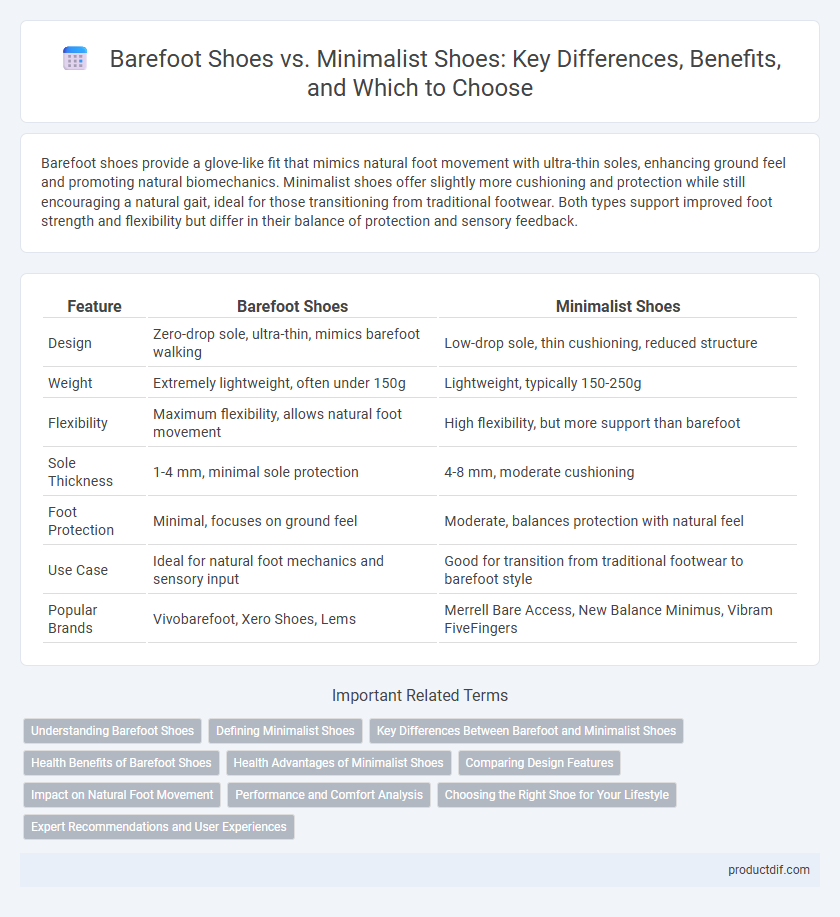Barefoot shoes provide a glove-like fit that mimics natural foot movement with ultra-thin soles, enhancing ground feel and promoting natural biomechanics. Minimalist shoes offer slightly more cushioning and protection while still encouraging a natural gait, ideal for those transitioning from traditional footwear. Both types support improved foot strength and flexibility but differ in their balance of protection and sensory feedback.
Table of Comparison
| Feature | Barefoot Shoes | Minimalist Shoes |
|---|---|---|
| Design | Zero-drop sole, ultra-thin, mimics barefoot walking | Low-drop sole, thin cushioning, reduced structure |
| Weight | Extremely lightweight, often under 150g | Lightweight, typically 150-250g |
| Flexibility | Maximum flexibility, allows natural foot movement | High flexibility, but more support than barefoot |
| Sole Thickness | 1-4 mm, minimal sole protection | 4-8 mm, moderate cushioning |
| Foot Protection | Minimal, focuses on ground feel | Moderate, balances protection with natural feel |
| Use Case | Ideal for natural foot mechanics and sensory input | Good for transition from traditional footwear to barefoot style |
| Popular Brands | Vivobarefoot, Xero Shoes, Lems | Merrell Bare Access, New Balance Minimus, Vibram FiveFingers |
Understanding Barefoot Shoes
Barefoot shoes provide a barefoot experience by offering minimal cushioning and thin soles that allow natural foot movement and ground feel. These shoes promote improved foot strength, balance, and posture by encouraging a natural gait and foot mechanics. Unlike minimalist shoes, barefoot shoes prioritize maximum sensory feedback and close-to-ground sensation without compromising basic protection.
Defining Minimalist Shoes
Minimalist shoes are designed to mimic barefoot walking by offering minimal cushioning, a thin sole, and little to no arch support, allowing for a natural foot movement and ground feel. They prioritize lightweight construction and flexibility, promoting improved foot strength and proprioception compared to traditional footwear. Unlike barefoot shoes that provide no barrier between the foot and ground, minimalist shoes still offer basic protection against sharp objects and rough terrain.
Key Differences Between Barefoot and Minimalist Shoes
Barefoot shoes provide a glove-like fit with ultra-thin soles that maximize ground feel and natural foot movement, while minimalist shoes offer slightly more cushioning and structure to protect against rough terrain. Barefoot shoes typically have zero drop and minimal arch support, emphasizing proprioception and toe splay, whereas minimalist shoes may include low drop and moderate arch support for gradual transition. Key differences center on sole thickness, flexibility, and design philosophy targeting either barefoot simulation or enhanced protection with minimal interference.
Health Benefits of Barefoot Shoes
Barefoot shoes promote natural foot movement by allowing the toes to splay and the foot muscles to strengthen, reducing the risk of foot deformities and improving balance. Their thin, flexible soles enhance proprioception, which helps prevent injuries by improving posture and gait mechanics. Studies show wearing barefoot shoes can alleviate chronic foot pain and contribute to overall foot health by encouraging proper biomechanics.
Health Advantages of Minimalist Shoes
Minimalist shoes promote natural foot movement and improve balance by providing a low-to-the-ground feel with minimal cushioning and support. They encourage stronger foot muscles and better posture, reducing the risk of common foot injuries like plantar fasciitis and shin splints. Unlike barefoot shoes, minimalist shoes offer slight protection while maintaining a natural gait, supporting overall foot health and biomechanical function.
Comparing Design Features
Barefoot shoes feature ultra-thin soles and zero heel-to-toe drop to mimic natural foot movement, while minimalist shoes offer slightly thicker soles and minimal cushioning for added protection. Barefoot designs prioritize maximum ground feel and flexibility, whereas minimalist shoes balance sensory feedback with enhanced durability and support. Both styles encourage natural foot biomechanics but differ in sole thickness, flexibility, and overall design intent.
Impact on Natural Foot Movement
Barefoot shoes replicate the feeling of walking barefoot by offering zero or minimal cushioning and a thin sole, promoting natural foot movement and enhanced proprioception. Minimalist shoes provide some cushioning and slight support while maintaining flexibility and a low heel-to-toe drop, allowing for a more natural gait compared to traditional footwear. Both styles encourage foot muscle strengthening and improved biomechanics by reducing restrictions and enabling a broader range of motion.
Performance and Comfort Analysis
Barefoot shoes mimic the natural shape of the foot and provide ultra-thin soles for enhanced ground feel, promoting natural gait and improved proprioception. Minimalist shoes offer slightly more cushioning and protection while maintaining flexibility and a low heel-to-toe drop, striking a balance between barefoot sensation and shock absorption. Performance studies show barefoot shoes enhance foot muscle activation and balance, while minimalist shoes reduce impact forces and improve comfort during longer runs.
Choosing the Right Shoe for Your Lifestyle
Barefoot shoes offer a more natural foot movement with ultra-thin soles that maximize ground feel, ideal for minimalistic runners and individuals seeking enhanced proprioception. Minimalist shoes provide a balance between protection and freedom, featuring slightly thicker soles and some support, suitable for everyday wear and moderate physical activities. Selecting the right shoe depends on your activity level, foot strength, and preference for sensory feedback versus cushioning.
Expert Recommendations and User Experiences
Experts recommend barefoot shoes for those seeking maximum natural foot movement and sensory feedback, emphasizing their ultra-thin soles and zero drop design for promoting proper posture. Minimalist shoes, favored by many users, offer slightly more cushioning and protection while preserving a lightweight, flexible structure conducive to a natural gait. User experiences highlight barefoot shoes' benefits in improving foot strength and balance, whereas minimalist shoes provide a comfortable transition from traditional footwear without sacrificing agility.
Barefoot Shoes vs Minimalist Shoes Infographic

 productdif.com
productdif.com